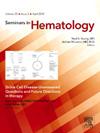Second-line treatment of diffuse large B‐cell lymphoma: Evolution of options
IF 4.1
3区 医学
Q1 HEMATOLOGY
引用次数: 0
Abstract
In the era of immunochemotherapy, approximately 60%-70% of diffuse large B-cell lymphoma (DLBCL) patients achieve remission with first-line rituximab-based chemoimmunotherapy. However, 30%-40% relapse after initial response to first-line therapy and, out of them, 20%-50% are refractory or experience early relapse. The second-line therapy algorithm for DLBCL has recently evolved, thanks to the recent approval of new therapeutic agents or their combinations. The new guidelines suggest a stratification of relapsed/refractory (R/R) DLBCL based on the time to relapse. For transplant-eligible patients, autologous stem cell transplant remains the preferred option when the patient relapses after 12 months from diagnosis, while anti-CD19 CART-cell therapy is the current preferred choice for high-risk DLBCL, defined as primary refractory or relapse ≤12 months. For transplant-ineligible or CAR T-cell therapy-ineligible patients, the therapeutic arsenal historically lacked effective options. However, new therapeutic options, including polatuzumab vedotin combined with bendamustine-rituximab and tafasitamab with lenalidomide, have been recently approved, and novel agents such as loncastuximab tesirine, selinexor, anti-CD19 CAR T-cell therapy, and bispecific antibodies have shown promising efficacy and manageable safety in this setting offering new hope to patients in this challenging scenario.
DLBCL 的二线治疗:选择的演变
在免疫化疗时代,约有60%-70%的弥漫大B细胞淋巴瘤(DLBCL)患者在接受基于利妥昔单抗的一线免疫化疗后病情得到缓解。然而,30%-40%的患者在对一线治疗产生初步反应后复发,其中20%-50%的患者为难治性或早期复发。由于新的治疗药物或其组合最近获得批准,DLBCL的二线治疗算法最近也发生了变化。新指南建议根据复发时间对复发/难治(R/R)DLBCL进行分层。对于符合移植条件的患者,自体干细胞移植仍是患者在确诊12个月后复发的首选方案,而抗CD19 CART细胞疗法则是目前高危DLBCL的首选方案,高危DLBCL的定义是原发性难治或复发≤12个月。对于不符合移植条件或不符合CAR T细胞疗法条件的患者,治疗手段历来缺乏有效的选择。然而,新的治疗方案,包括波拉珠单抗维多汀联合苯达莫司汀-利妥昔单抗和他法西他单抗联合来那度胺,最近已获得批准,而且长卡素单抗泰西林、西利奈索、抗CD19 CAR T细胞疗法和双特异性抗体等新型药物在这种情况下显示出了良好的疗效和可控的安全性,为面临这一挑战的患者带来了新的希望。
本文章由计算机程序翻译,如有差异,请以英文原文为准。
求助全文
约1分钟内获得全文
求助全文
来源期刊

Seminars in hematology
医学-血液学
CiteScore
6.20
自引率
2.80%
发文量
30
审稿时长
35 days
期刊介绍:
Seminars in Hematology aims to present subjects of current importance in clinical hematology, including related areas of oncology, hematopathology, and blood banking. The journal''s unique issue structure allows for a multi-faceted overview of a single topic via a curated selection of review articles, while also offering a variety of articles that present dynamic and front-line material immediately influencing the field. Seminars in Hematology is devoted to making the important and current work accessible, comprehensible, and valuable to the practicing physician, young investigator, clinical practitioners, and internists/paediatricians with strong interests in blood diseases. Seminars in Hematology publishes original research, reviews, short communications and mini- reviews.
 求助内容:
求助内容: 应助结果提醒方式:
应助结果提醒方式:


